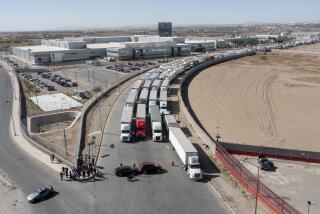Building a Mexican Giant
- Share via
CUAUHTINCHAN, Mexico — On a parched hillside here in central Mexico, workers labor around the clock extracting one of the world’s most coveted commodities.
It isn’t sold by the ounce on international exchanges, but in 110-pound bags in home improvement stores.
The product is cement, a mixture of iron oxide, gypsum, clay and the reddish limestone quarried from these slopes about two hours southeast of Mexico’s capital. Not exactly the stuff of a prospector’s dream. But for Cemex, the world’s third-largest cement maker, the pale dust might as well be gold.
Last year, Cemex turned that simple yet essential commodity into net income of $2.2 billion on sales of $15.3 billion, aided by its acquisition of British cement maker RMC Group. The $5.8-billion deal nearly doubled the company’s size. Even for growth-minded Cemex, which has snapped up 16 major cement firms since the late 1980s, it was an aggressive move.
Some analysts worried that Cemex was paying too much for an underperforming European company when much of the action was in booming Asia. Still, Cemex managed to slash costs and free up buckets of cash to start paying down the $10 billion in debt weighing on its balance sheet after the purchase. The company delivered record earnings last year, and its stock ended 2005 up 63%.
Cemex shares closed at $62.03 on Friday, down 2 cents. Despite a recent pullback, the stock is up 6% on the year.
In a recent interview in the company’s marble-and-glass headquarters in the northern Mexico city of Monterrey, Chief Executive Lorenzo Zambrano rattled off growth and profitability statistics that have silenced the doubters -- at least for the time being.
“I have been hearing that for 20 years,” said the 62-year-old grandson of one of Cemex’s founders, referring to the second-guessing of his empire building.
Under his leadership, Cemex has morphed from a regional player into a global powerhouse with operations in more than 50 countries and 50,000 employees worldwide.
Mexico is no longer even its biggest market. That distinction belongs to the United States, where RMC’s U.S. facilities, added to previous acquisitions north of the border, have turned Cemex into America’s largest maker of cement and ready-mix concrete, the mixture of cement, sand, gravel and water that tumbles around in the cylinders of cement trucks. The U.S. is now the source of more than one-quarter of Cemex’s revenue.
That could be a liability as the nation’s red-hot housing market cools. But the company has learned to ride the peaks and valleys of a cyclical industry. For two decades, Cemex has delivered compounded annual growth topping 20% in sales and earnings before interest, taxes, depreciation and amortization. It has also built a powerful global brand from a commodity product by combining savvy marketing with technological sophistication -- rare proficiencies in a hard-hat industry.
“They had a vision of the company and what it would look like and how it would operate, and they have followed through pretty consistently,” said international business expert John Roberts, who has studied the company as an economics professor at Stanford University’s Graduate School of Business, Zambrano’s alma mater.
“I teach it as one of the shining examples of what comes from good strategy, good organization and good management,” Roberts said.
Those aren’t qualities typically associated with many of Mexico’s largest companies, where being an FOP, or friend of the president, has long trumped having an MBA. Key sectors of Mexico’s economy are dominated by public-sector monopolies and private oligopolies that economists say have saddled consumers with high prices while stunting the nation’s growth.
It’s a criticism that has also been leveled at Cemex, which controls about half the market in Mexico, where cement prices are higher than those typically found in the United States. Cemex derived 21% of its sales but 45% of its operating income from Mexico in 2005.
The company was instrumental last year in pushing the Mexican government to prevent a ship loaded with low-cost Russian cement from offloading its cargo. Publicity about the stranded vessel and its hapless crew became an embarrassment to the Mexican industry, which at the time was battling to force the United States to open its market to more cement from south of the border.
The U.S. government for years slapped anti-dumping duties on imports from Mexico, concluding that Mexican firms were selling cement in the U.S. at times for less than half what they were charging at home.
However, a resolution to that long-running dispute was reached this year. All duties and quotas on Mexican cement entering the U.S. market will be lifted by 2009, which analysts say could help ease U.S. shortages while benefiting exporters such as Cemex.
Zambrano, a dapper, courtly man whose personal fortune is estimated at $1.8 billion by Forbes magazine, chafes at the notion that his firm is fleecing its impoverished countrymen, the majority of whom earn less than $13 a day. Most families in Mexico build their homes one tiny room at a time, buying cement by the bag instead of the truckload as is typical in the United States.
Selling a bulky commodity as if it were consumer product requires complex, costly distribution, Zambrano said, by way of justifying the relatively high prices.
Analysts say no one does it better than Cemex. The company pioneered the use of sophisticated logistics technology to dispatch cement to job sites as quickly as doughnuts and coffee. In Mexico, Cemex sponsors soccer teams and builds brand loyalty with small but meaningful touches, such as the parties it hosts throughout the country every May 3 to celebrate El Dia de la Santa Cruz, or Holy Cross Day, the traditional feast day for construction workers.
To professionalize its base of about 5,000 independent distributors in Mexico, Cemex has converted about half of them since 2001 to a retail concept known as Construrama. Dealers that pay to join the network and turn their building-supply stores into Construrama outlets get help with store layout, administration, financing and other matters.
That’s a lot of hand-holding. But the bottom line is clear, said Francisco Garza, president of Cemex’s North American operations. When the distributors sell more, Cemex sells more. “We want them to increase their business,” he said.
Cemex has also found a way to peddle more cement to the nearly half of Mexican families who live in poverty by offering them something most can’t get anywhere else: credit.
Shut out by banks, Mexicans have long embraced the use of lending circles, known here as tandas. Families or neighbors kick in a few pesos a week to help one another pay for weddings, appliances and other major purchases.
Cemex has updated the tradition to finance home expansions with a program called Patrimonio Hoy, or Patrimony Today. The company provides professional design services and lends small groups of borrowers 80% of the cost of building materials, secured by nothing but the peer pressure of the lending circle. When one family’s project is completed and paid for, the cycle restarts with the next member of the group.
Started in 1998, the program has helped 140,000 families expand their homes, with a default rate of less than 1%, according to Hector Ureta Morales, director of social programs for Cemex. Projects that used to take years are now completed in months. Ureta said the model was such a hit in Mexico that the company recently expanded it to Colombia and Nicaragua and would soon add Venezuela and Costa Rica. He said the program was profitable and made good business sense because families were likely to call on Cemex when it came time to add another room.
“We’re building brand loyalty,” he said.
Cemex has launched a related concept in the United States known as Construmex to channel into home construction some of the $20 billion that migrants send back to their families each year. Workers in the U.S. can walk into a Construmex office, design their home addition and get the materials delivered to relatives in Mexico. Ureta said migrants saved the hefty fees charged by money transfer companies while maintaining control of how their remittances were spent in their absence.
Such grass-roots knowledge has helped Cemex thrive in developing markets where others fear to tread.
The firm made a rare misstep in Indonesia in 1998, when it bought a minority stake in a cement plant that the government was unloading during its privatization binge. The public reacted angrily to what it viewed as a sellout of Indonesia’s patrimony to foreigners, and officials never made good on a contract to let Cemex buy a controlling interest.
Cemex recently agreed to sell its stake to an Indonesian buyer for $337 million, recording a gain on its $230-million investment but suffering a loss in the time and effort expended to develop that market.
“They miscalculated the country-specific risk,” said Carlos Peyrelongue, a construction industry analyst with Merrill Lynch in Mexico City.
Cemex executives appear determined not to let that happen again. While other companies are rushing into China, Cemex is biding its time, looking for opportunities that meet its strict investment criteria.
“We are not going to China just because of the bandwagon thing,” said Hector Medina, the head of planning and finance. “China is still going to be there in 50 years.”
Founded in 1906 by a Mexican businessman who would eventually merge his cement firm with one started by Zambrano’s grandfather, Cemex did little business outside Mexico until 1992, when it purchased a couple of companies in Spain.
It was a period of transformation for Mexico’s economy, which was opening up under then-President Carlos Salinas de Gortari, an architect of the North American Free Trade Agreement. Zambrano, who had held the top spot at Cemex for only a few years, said he knew the company would have to grow or risk being swallowed up by a competitor.
“I wanted my job for a long time, and I wanted to keep it,” said Zambrano, who as a boy made it his goal to someday run the company. To prepare for the task, he earned an engineering degree at Tech de Monterrey, sometimes called Mexico’s MIT, and an MBA from Stanford.
The lessons learned from integrating the Spanish firms became what is now known as the Cemex Way, which relies on technology and automation to reduce costs, boost productivity, drive quality and set performance benchmarks worldwide. Managers at the company’s Monterrey facility can check the kiln temperature at a plant in Egypt or sales figures from the Philippines on their laptop computers. English is the official language of company business.
Zambrano said Cemex planned to wring $360 million in savings out of RMC by 2007. He is particularly proud of a turnaround at a troubled plant in Rugby, England, which was running at only 70% of capacity when Cemex bought it. His transition SWAT team boosted that figure to 90% in 90 days, in part by silencing nonessential alarms that had shut down the kiln dozens of times a year.
A simple thing perhaps, but an example of how Cemex makes use of both high- and low-tech means to produce more cement at lower cost with fewer people.
“They had alarms for everything,” said the white-haired Zambrano with obvious disdain. “What we’re doing here is not a revolution. It’s just good management.”
More to Read
Inside the business of entertainment
The Wide Shot brings you news, analysis and insights on everything from streaming wars to production — and what it all means for the future.
You may occasionally receive promotional content from the Los Angeles Times.










